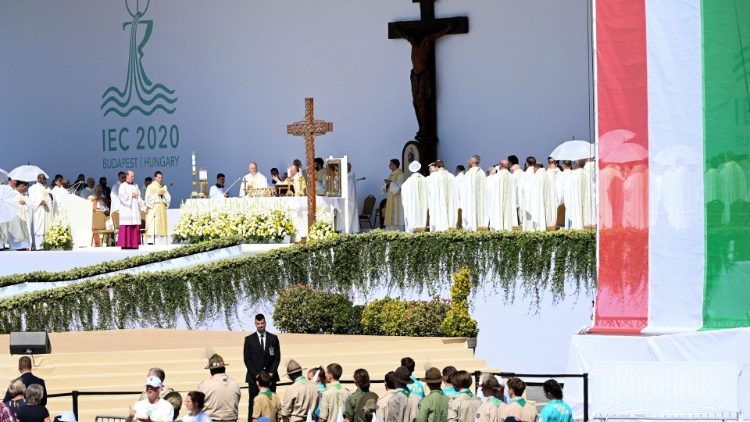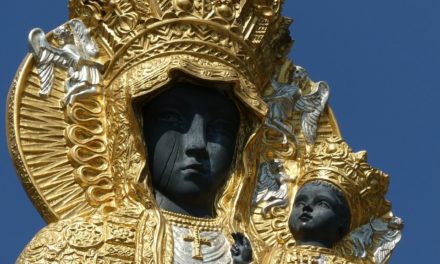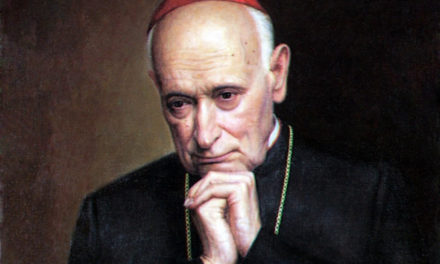At Easter - if nothing else, through television - we understandably see the Holy Father, the Pope, several times, with many symbols associated with his person and post.
Fishing ring
Among the Pope's insignia is the embossed gold ring that depicts St. Peter the Apostle practicing his original occupation, fishing. Hence its name: fisherman's ring - which refers to the Gospel scene of the apostle Peter's invitation ("I make you a fisher of men" - Mk 1,17). The pope's name can be read around the relief. After the Pope's death, his ring is broken. The new ring is already present at the conclave, the space for the name is omitted.
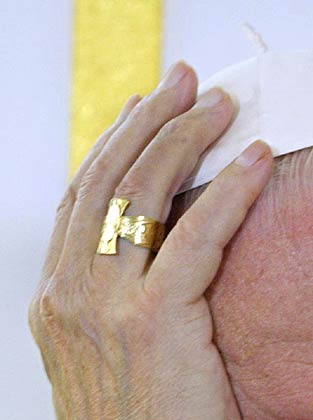
For the first time the XIII. century, the pope's fisherman's ring is mentioned, which was originally used to seal his personal letters, then among the official documents, the so-called used to authenticate brevets. At his coronation, and nowadays at the beginning of his service in St. Peter's, the cardinal camerlengo puts it on the new pope's finger. And when it dies, the camerlengo is also the one who takes care of its destruction in order to prevent abuses, namely with the help of a press. The latter XXIII. Since John's death, it has been out of the habit.
Peter's keys
The Pope and the Holy See in the XIII-XIV. since the 19th century, its official insignia is two keys crossing each other diagonally, with the tiara above them, which appears on the papal flag, medals, and behind its coat of arms. In its other occurrences, it also refers everywhere to the connection with the Holy See.
The keys symbolize the power of loosing and binding, i.e. the completeness of the jurisdiction of Peter's successor (cf. Mt 16:19: "I give you the keys of the kingdom of heaven. What you bind on earth will be bound in heaven, and what you loose on earth will be loosed also dissolved in the heavens.").
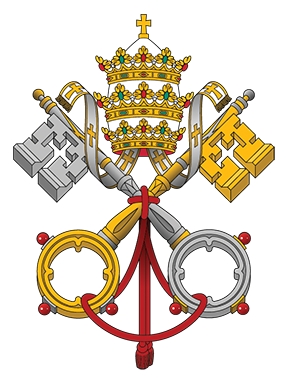
The golden key on the left side of the coat of arms represents spiritual power, and the silver key on the right represents worldly government power. The two are connected by a red cord, which represents the unity of the two types of power realized in the papal office. The head of the keys is located at the bottom, as if in the hands of the Pope, and the cross-patterned plumage of the keys refers to the redemptive work of Christ.
Papal flag
The papal flag is square and divided vertically. The part closer to the rod is yellow (gold), and the other part is white (silver), the center of the latter is decorated with the papal insignia. Its present form dates back to the 19th and 20th centuries. was formed in the century. Previously, the Pope used the yellow-red colors representing the Roman Senate and the people (these are still the colors of the city of Rome). When Napoleon occupied the Papal States, he conscripted the papal armed forces into the French army, leaving their own insignia. Then VII. Piusz ordered the bodyguard standing by him to wear yellow and white cockades as a way of distinguishing themselves, presumably based on the golden and silver keys of the papal insignia. The final form of the papal flag IX. It was won during Piusz, which has been the internationally recognized official flag of the Vatican City State since the Lateran Treaty of 1929.
The flag of the Holy Church of Rome dates back much earlier, the first depictions of which date back to the VIII-IX centuries. century. Appearance VIII. It took its final form under Boniface: red silk fabric decorated with six-pointed gold stars, in the middle with the two keys and the so-called with an umbrella. The flag accompanied the Holy Father at major church and secular celebrations, as well as during his travels, but the papal armies also took it with them into battle (for example, to the Lepantos).

The standard-bearer (vexillifer or gonfaloniere) of the Holy Church of Rome was one of the highest honors a lay person could receive. In the Middle Ages, the title was borne by kings and princes (among them, at the beginning of the 15th century, Antiking László of Naples, who fought for the Hungarian throne against Sigismund), later it was inherited in a Roman aristocratic family. The standard-bearer was also the captain of the light cavalry and then of the noble bodyguard, until VI. Pál abolished it together with many other court offices in 1968.
Papal cross
In processions and on other solemn liturgical occasions, a cross was carried right in front of the pope since the 5th century. The papal godfather was at first one of the Roman deacons, then the youngest case student of the Rota Romana. Its use can still be observed today during ceremonial processions, for example when the Pope steps out onto the balcony of St. Peter's Basilica during the UrbietOrbi blessing. However, he himself only takes it into his hands on specific occasions.
The Pope does not use a shepherd's staff with a hooked end like bishops. His own shepherd's staff, the so-called ferula is an isosceles cross affixed to the end of a human-tall stick. Originally, it was only used in certain ceremonies, such as episcopal consecration or the festive mass, entry and exit.
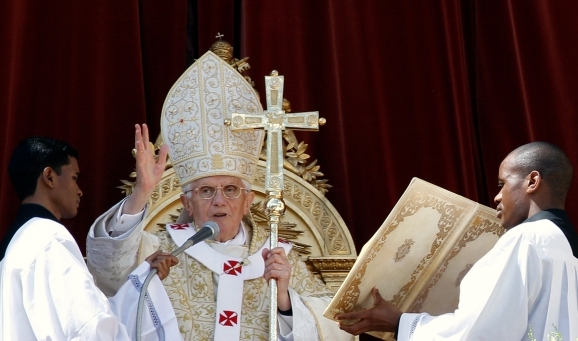
The XVII. It was abandoned in the 6th century and only in the 6th century. Pope Paul renewed its use when he renounced many previous papal insignia. It had several versions, the well-known ferule shaped like a slightly forward silver cross was finally made by Lello Scorzelli in the early 1970s. It was used by John Paul I and II. János Pál too, now in the same way as the bishop's shepherd's staff.
During the Holy Week ceremonies of 2008 XVI. Pope Benedict replaced this with a gilded cross, which is the second It was used as a papal cross before the Vatican Council.
Source: Hungarian Courier
(Cover photo: Pope Francis' closing mass at the Eucharistic Congress. Image source: Vatican News )

